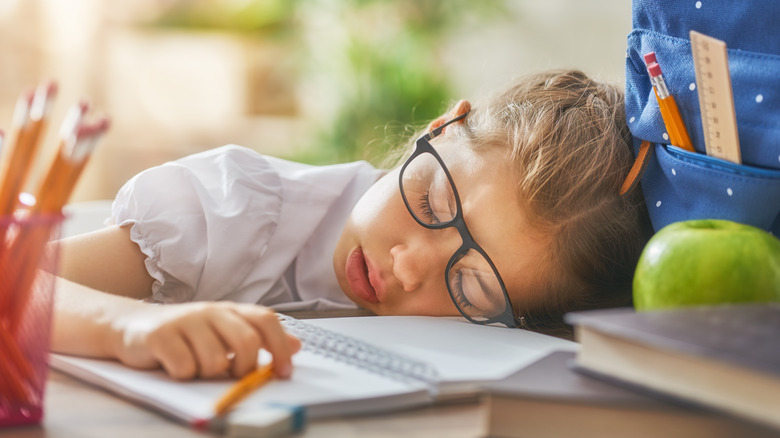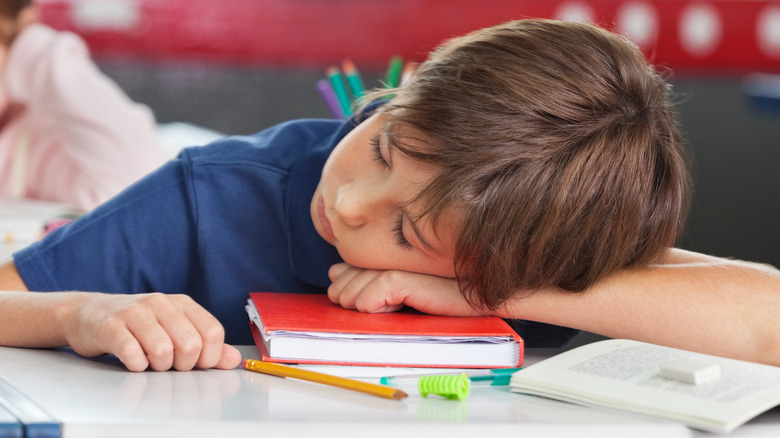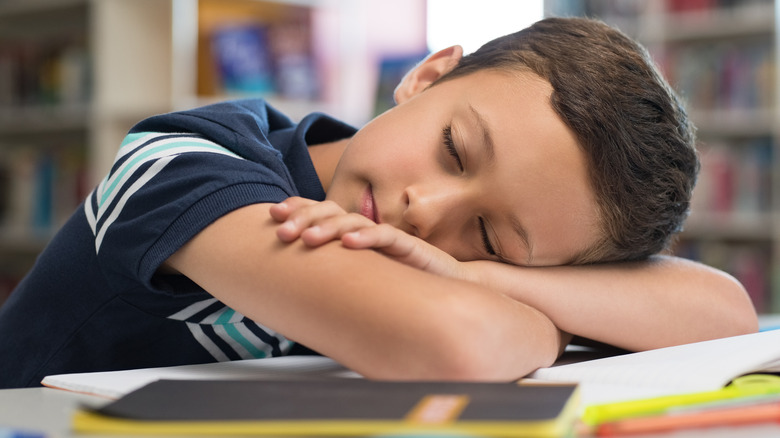
Yuganov Konstantin/Shutterstock
By Hope Campbell/Sept. 3, 2021 10:09 am EDT
The classroom is supposed to be a place for learning, not sleep. Many adults can still remember falling asleep in class as a child and possibly being disciplined for such an act, via detention or even suspension. The idea of students sleeping in class might be horrifying to you and goes against everything you learned about proper school behavior as a child, but it might not be as horrifying to today’s teachers and students as it was to previous generations.
In fact, some teachers now freely allow children to fall asleep in their classroom and see nothing wrong with it. They might not be giving a child a specific time to sleep, but if a student puts their head down and sleeps for just a bit, it’s becoming a perfectly acceptable behavior in an era where children’s needs are understood more than ever before. But why is it okay for these needs to be met in a classroom and not at home?
How much sleep do kids really need?

As infants, children need the most amount of sleep they will ever need in their life, according to the American Academy of Pediatrics (AAP). The AAP recommends that 4-12-month-olds should be sleeping most of their days away with 16 hours of sleep, including naps. Between the ages of 1 and 2, children need 11-14 hours of sleep, also including naps. Between ages 3 and 5, kids need 10-13 hours of sleep, and should still be getting some of that sleep from naps. When kids reach school age, the AAP wants 6-12-year-olds to get 9-12 hours of sleep, and 13-18-year-olds to get 8-10 hours of sleep.
The AAP feels that inadequate sleep can be detrimental to a child’s life and posted a statement explaining why. “Regularly sleeping fewer than the number of recommended hours is associated with attention, behavior, and learning problems. Insufficient sleep also increases the risk of accidents, injuries, hypertension, obesity, diabetes and depression.”
Pediatric pulmonologist Dr. Lee J. Brooks explained what could happen in classrooms if children don’t get adequate sleep. “You might see poor school performance, you might see kids labeled as troublemakers when in reality they just don’t get enough sleep.” That’s exactly what some teachers are seeing in their classrooms.
Teachers are becoming more understanding about students' sleep habits

Teachers are now advocating for allowing students to nap in classrooms if they feel it’s needed. Teacher Brandon Holeman posted a Tik Tok video with this advice: “Sometimes the nicest thing a teacher can do for a student is let them come in, lay their head down and go to sleep,” he said. “Life can hit hard, and we all need some grace.” He then cited the example of a student who had experienced a loss in the family, but still made the effort to show up at school.
Another Tik Tok teacher known as @ms.old shared a video saying students falling asleep in class doesn’t bother her at all because she finds it beneficial. “Sometimes when a student falls asleep in my class, I just let them sleep,” she said. “I’ve actually learned from a few of my students that the only reason they’re sleeping is because it’s the only opportunity they’ve had to sleep. … I’ve actually had some students say to me that it’s the only place they feel safe to fall asleep.”
She also said that sleeping in class can also help them with their learning when they are awake. “Usually, when they’ve had a little nap in the morning, they’re more refreshed for the rest of the day … less likely to have an attitude problem [and] more likely to be motivated to do the next activity.”
Sometimes teachers find an underlying problem when students sleep in class

Not getting enough sleep or needing even more sleep can also be a sign of depression. According to WebMD, signs of depression in children and adolescents can include trouble focusing, crying, social difficulties, and yes, fatigue.
Therapist and licensed clinic social worker Cynthia Catchings explained to USA Today how depression can affect children and their academic performance. “We think about children as happy human beings that are just completing their homework at school and living a happy life,” she said. “But sometimes we can see that depression can be actually diagnosed or seen in children as small as 5, 6 years old.”
Catchings also said that the everyday stressors in a child’s life might also affect their sleep. “Just thinking about ‘I didn’t complete the homework,’ ‘I’m afraid to ask this question’ and [students] cannot sleep [or are] waking up in the middle of the night worried about it” (via USA Today).
Source: Read Full Article
